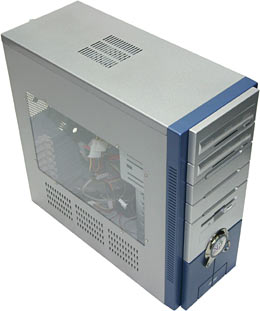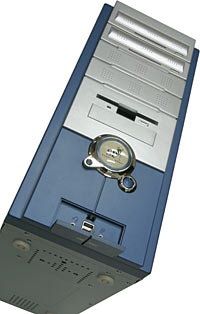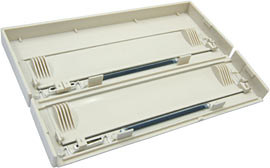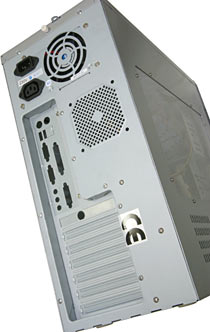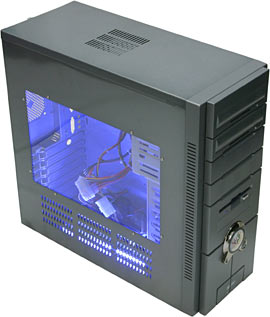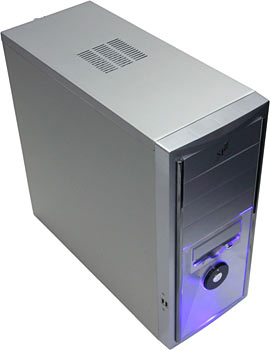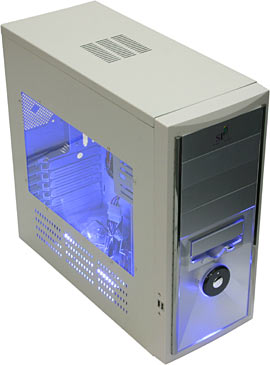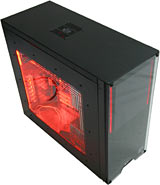
Codegen ATX-6061 and ATX-6063 computer cases
Review date: 11 October 2002.Last modified 03-Dec-2011.
If you want a fancy looking computer case with which to (in theory) impress your friends, you should expect to pay quite a bit of money. Windows and aluminium panels and lights and associated bells and whistles do not, typically, come cheap.
Lian Li and Cooler Master, for instance, make a variety of great looking aluminium PC enclosures - but you'll pay easily twice as much for a Lian Li without a Power Supply Unit (PSU) as you'll pay for a passable plain steel case with a PSU.

This little lot, therefore, took me rather by surprise.
At a glance, you'd say these were fairly expensive tweaker-cases, since two of them have aluminium panels and three of them have side windows to show off the computer's guts. The ones with windows even come with a blue cold cathode fluorescent light (CCFL) as part of the package.
But these Codegen cases are actually cheapies. They sell for a lousy $AU148.50 each from Aus PC Market, and that price includes a 300 watt PSU and delivery to customers in the Sydney metropolitan area, here in Australia. Buyers from elsewhere in Australia will pay more for delivery; buyers from outside Australia will need to find someone else to shop with, as international shipping rates for computer cases are ludicrous.
Australian buyers champing at the bit to order can visit the Aus PC site by clicking here. Advertisement ends.
Now, $AU150-odd is about twice what you'll pay for the very cheapest and nastiest cases, with awful fit and finish issues, razor-sharp edges all over the inside, and PSUs which may or may not have output to match their alleged rating - and which may or may not decide to apply mains voltage to your motherboard after a month or two.
Since the Codegen cases have knobs on, though, the obvious question is - "are these cases just awful $AU75 bargain basement jobs with another $AU75 of tinsel added?"
Let's find out.
All four of these cases are so similar on the inside that there was no need for me to do full photo shoots on all of them. Ignore the panel finish and the front bezel design, and they're all exactly the same. This silver and blue ATX-6061 (a 6061C9, if this is to be believed) is, therefore, the only one that I'll show you from all sides.
Note the top panel of the case in the above picture; that grille has an 80mm exhaust fan under it. This case has two more fan mounts - one rear, one front - but you'll have to supply your own fans for those.
Even one extra fan's not a bad deal for a cheap-ish case, though.
The 6061 front panel gives the vague impression that a bit's missing, because there's a protruding central column of plastic. The column incorporates the four 5.25 inch drive bays, the two externally accessible 3.5 inch bays, a rather flashy central chromed boss incorporating the power and reset buttons and a big "Super Power" logo, and a door at the bottom behind which are two USB ports and two 1/8th inch stereo audio connectors.
There's a reason for this sticky-out bit, though; it allows you to install beige drives in the top two 5.25 inch bays and not have to look at them.
This is possible because of the removable bezel-thingy at the top of the panel, which has lightly spring loaded doors in it. The doors are made to flop down when a drive tray ejects (they won't work with slot-load drives), and they seem likely to operate quite well.
Here's the back of the bezel-thingy; both bay covers come off in one lump. There are see-through blue plastic inserts that will, with any luck, line up with your drives' activity lights...
...and there are these reconfigurable button-push-transfer widgets, too. By moving around little plug-in plastic inserts, you can set up the widgets to properly push the eject button of pretty much any tray-load drive that's decent enough to have an eject button on the lower right side of its front panel, which is where pretty much all of them are. There's no way to access a play button, volume control or headphone socket, but not all drives have those, and many people don't use them anyway.
Cases that put a lot of plastic in front of your drives for cosmetic reasons are, generally, ergonomic disasters. The decorations get in the way. The ATX-6061 is somewhat guilty in this regard, because it puts sculpted plastic between you and your floppy drive. As usual for cases that do this, there's an eject-button-prodder that ought to work fine, but it can be hard to get disks in and out of a recessed floppy drive, especially if you have big fingers.
If this really honks you off, you can install your floppy drive in the lower of the two externally accessible 3.5 inch bays; you should be able to mount it far enough forward to be flush with the front panel. Then you'll only be annoyed when you absent-mindedly poke a floppy into the upper slot, behind which will be no drive.
The back panel. Note the (unoccupied) exhaust fan grille, a CE Mark sticker that definitely meets the minimum size requirement, and two small things at the top.
One of those things is a little padlock tab, which is made of the mildest of mild steel and could be broken off by a determined 10 year old, but which shows willing. The other of those things is a plastic-ended thumbscrew, which is the only fastener holding the top and side panels on.
This is good, because it means you only need to undo one screw to get into the case. But it's bad, because the one-screw design means this cases uses the "capped" configuration, where the top panel locks the side panels into place. To get the side off, you have to get the top off first.
Doing this could be more annoying, but it could also be easier. The Codegen cases have passable panel fit, but they're well below the standards set by the expensive tweaky-cases. Getting panels on and off commonly takes more than one go, as you try to line up the numerous tabs and slots. Codegen and many other makers of cheaper cases have to use lots of attachment points for the panels, because their manufacturing tolerances are sufficiently large that the panels would rattle if they didn't have lots of anchors.
That said, though, I didn't need a rubber mallet to take this case apart or put it back together again. That's more than I can say for some cases I've seen.
I also didn't lose a pint of blood opening and closing this box. The Codegen cases have some sharp edges inside, but most of the edges are rolled and thus safe to touch without aramid fibre gloves.
The window in the side panel looks bubbly and scratched and nasty when you get the case out of the box. This is by design...
...because it has a peel-off protective film on the inside. Why the inside? Because that's where the case's cables and screw-bag and such are bouncing around while the case is being shipped.
Inside, the ATX-6061 isn't anything special, but it's got a decent number of drive bays; there are five more 3.5 inch bays under the two that're accessible from the outside. The bays are not, of course, removable; everything's pop-riveted together.
The two front audio ports are connected to perfectly unremarkable loopback leads with 1/8th inch stereo plugs on them. You feed them out of a hole in the back of the case and plug them into your normal audio sockets, if you want to use them.
The front USB ports have single-pin micro-plugs, four pins per port; to connect them, you need to have a motherboard with USB headers on it (pretty much every board has them, these days) and know the connector pinout (which ought to be in the motherboard manual). Good luck.
You also get clip-off rear slot covers. No screws, just a plastic spring-tab arrangement. Nice.
The Codegen power supply has the usual complement of connectors, including an ATX12V plug for motherboards that need one. There are only four large "Molex" drive power connectors and one small floppy power plug, though; if you want to install more than five drives, you're going to need Y-adapters or a new PSU. If you want more than a couple more drives, don't make Y-adapter Christmas trees; get a better PSU.
The top exhaust fan has a passthrough Molex power connector, so it doesn't use up a PSU plug.
The Codegen PSU's 300 watt rating is an aggregate for all of its rails, including the low current negative ones, but that's not a big deal. It ought to be perfectly adequate for most PCs. Something better, like a plain grey-box AOpen unit, would be a good idea if you're expecting to run the computer all day every day for a long time. You can't expect too much from cheap PSUs.
The windowed Codegen cases come bundled with a CCFL, as I mentioned above. It's easy to set up, provided you take note of the "AC" and "DC" notation next to the barrel plug sockets on the power supply box, and plug the included Molex plug power adapter into the DC one and the lamp into the AC one. The control box also has a sound triggering option, though that's unlikely to be very useful when it's sitting inside a computer case.
I didn't take a picture of the blue and grey ATX-6061 with its CCFL installed and running...
...but I did photograph the grey 6061 in glow mode. The CCFL makes the louvred ventilation holes in the side panel more obvious.
Apart from the finish - which, again, is pretty good for the price - this ATX-6061 is exactly the same as the other one.
If you can live without the window and light, by the way, then you can get a grey ATX-6061 without either, for a mere $AU104.50 including Sydney delivery.
This ATX-6063 is not the same as the ATX-6061. Inside, it is; it's got the same drive bay configuration, the same PSU, the same fan mount points, and the same factory-installed top fan. But its panels are aluminium, with a pleasing brushed-metal plain-anodised finish, not at all unlike what you get on the far more expensive silver Lian Lis. The panels still don't fit terribly well, but they neither rattle nor stick. What do you want from life.
This case has no side window, and comes with no CCFL. It still glows, though; when its PSU's powered up, an LED lights up the clear acrylic plate that decorates the bottom of the front panel.
The effect is rather pleasing, if you ask me, and it's not bright enough to be a distraction. You can always unplug it if you don't like it; it runs from another simple passthrough Molex-plug connector.
The front panel on this case is very good for the money, actually; you don't get any drive-hiding bezel-things, but there are two reasonably tasteful vertical chromed rails flanking the drive bays, the recessed floppy drive looks good and is no harder to use than the one in the ATX-6061, and the power/reset button surround doesn't leap out and shout at you either.
From the side, the ATX-6063 front panel looks even more interesting. There's actually a semi-conical depression behind the buttons, which does nothing but looks cool. You also get another two USB ports, on the side edge, with audio connectors above and below them. The audio connectors have the same loopback cables as the ATX-6061 front panel connectors.
Here's the beige version of the above. No zooty brushed-metal finish, but a side window and CCFL to make up for it.
Overall
If you're not enough of a show-off to be interested in a side window, but you'd like a fancy-looking case for your new PC, the windowless brushed-aluminium ATX-6063 is a great deal. It's not terribly nice to work on, with no slide-out motherboard trays or easy-access panels or removable drive cages, but it's better than the real bargain basement brigade.
Business buyers may be interested in this case, as well as home users. If you want your office PCs to look stylish, but don't want to drop big bucks on Lian Li or Cooler Master or other expensive aluminium enclosures, then brushed-metal ATX-6063s ought to fit the bill nicely. If your IT staff have to build them into computers then they're unlikely to be overjoyed by the task, but these things are no worse to work on than the cases that business PCs usually have, and from the outside they look every bit as spiffy as the chic-er brand name boxes that usually get bought in a situation like this.
If, on the other hand, you're a mug lair on a budget, then the windowed Codegen cases are for you. Not too awful to work on, plenty of drive bays, a decent stock PSU, and not bad looking at all.
If you're fiddling with the hardware all the time then these cases will annoy you quite a lot more than a Lian Li would. But for $AU148.50, they're a bargain.
Recommended.
Aus PC Market don't sell the Codegen cases any more, but they've got plenty of others!
